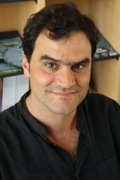Specialized iNANO Lecture: Exciting Spin, Forces and Photons in Molecular Tunneling Junctions
Research professor Nacho Pascual, CIC nanoGUNE, San Sebastian, Spain
Info about event
Time
Location
Meeting room 1520-732, Department of Physics and Astronomy, Langelandsgade 120, 8000 Aarhus C

Research professor Nacho Pascual, CIC nanoGUNE, San Sebastian, SpainExciting Spin, Forces and Photons in Molecular Tunneling JunctionsAn electron current passing through nanosystems undergoes a variety of phenomena involving the exchange of energy with atoms/molecules. These are called inelastic currents, and allow us to investigated excitations of materials at the atomic scale. Using scanning tunneling microscopy (STM) at cryogenic conditions we study inelastic processes induced by tunneling electron currents such as spin excitations, molecular conformational transformations, or vibrational heating. In this talk I will present three of these subjects: I) We induce spin excitations in paramagnetic molecules on a superconducting substrate. An interesting outcome is that the lifetime of excited states amounts to a few nanoseconds, much larger than on normal metal surfaces. This is interpreted as due to the depletion of electronic states within the superconducting energy gap at the Fermi level, which prohibits pathways of energy relaxation into the substrate. II) Molecular conformational changes can be induced by inelastic tunneling electrons. We identify these conformational changes through the forces exerted on the tip of an STM. III) Tunneling electrons through molecular junctions can also induce light emission mediated by the excitation of localized plasmon modes at the tunnel junction. The spectroscopic characterization of emitted photons reveals “anti-stokes”-like phenomena, which we interpret as induced by hot molecular modes, excited by inelastic tunneling electrons. This allows us to provide an insight into vibrational temperature induced by inelastic electrons. | |
| Host: Professor Philip Hofmann, iNANO & Department of Physics and Astronomy |
